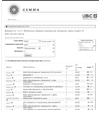Sharing and reusing gene expression profiling data in neuroscience
- PMID: 17917127
- PMCID: PMC2980754
- DOI: 10.1007/s12021-007-0012-5
Sharing and reusing gene expression profiling data in neuroscience
Abstract
As public availability of gene expression profiling data increases, it is natural to ask how these data can be used by neuroscientists. Here we review the public availability of high-throughput expression data in neuroscience and how it has been reused, and tools that have been developed to facilitate reuse. There is increasing interest in making expression data reuse a routine part of the neuroscience tool-kit, but there are a number of challenges. Data must become more readily available in public databases; efforts to encourage investigators to make data available are important, as is education on the benefits of public data release. Once released, data must be better-annotated. Techniques and tools for data reuse are also in need of improvement. Integration of expression profiling data with neuroscience-specific resources such as anatomical atlases will further increase the value of expression data.
Figures






Comment in
-
Software development vis à vis collaboration in interdisciplinary research.Neuroinformatics. 2007 Fall;5(3):176-7. doi: 10.1007/s12021-007-0008-1. Neuroinformatics. 2007. PMID: 17917128 No abstract available.
Similar articles
-
Neuroinformatics: the integration of shared databases and tools towards integrative neuroscience.J Integr Neurosci. 2002 Dec;1(2):117-28. doi: 10.1142/s0219635202000128. J Integr Neurosci. 2002. PMID: 15011281 Review.
-
Data sharing for computational neuroscience.Neuroinformatics. 2008 Spring;6(1):47-55. doi: 10.1007/s12021-008-9009-y. Epub 2008 Feb 8. Neuroinformatics. 2008. PMID: 18259695
-
A Review of the Application of Spatial Transcriptomics in Neuroscience.Interdiscip Sci. 2024 Jun;16(2):243-260. doi: 10.1007/s12539-024-00603-4. Epub 2024 Feb 20. Interdiscip Sci. 2024. PMID: 38374297 Review.
-
E-neuroscience: challenges and triumphs in integrating distributed data from molecules to brains.Nat Neurosci. 2004 May;7(5):467-72. doi: 10.1038/nn1229. Nat Neurosci. 2004. PMID: 15114360
-
Big data from small data: data-sharing in the 'long tail' of neuroscience.Nat Neurosci. 2014 Nov;17(11):1442-7. doi: 10.1038/nn.3838. Nat Neurosci. 2014. PMID: 25349910 Free PMC article. Review.
Cited by
-
Data reuse and the open data citation advantage.PeerJ. 2013 Oct 1;1:e175. doi: 10.7717/peerj.175. eCollection 2013. PeerJ. 2013. PMID: 24109559 Free PMC article.
-
Data publishing and scientific journals: the future of the scientific paper in a world of shared data.Neuroinformatics. 2010 Oct;8(3):151-3. doi: 10.1007/s12021-010-9084-8. Neuroinformatics. 2010. PMID: 20835853 Review. No abstract available.
-
Quantitative investigations of axonal and dendritic arbors: development, structure, function, and pathology.Neuroscientist. 2015 Jun;21(3):241-54. doi: 10.1177/1073858414540216. Epub 2014 Jun 27. Neuroscientist. 2015. PMID: 24972604 Free PMC article. Review.
-
The reuse of public datasets in the life sciences: potential risks and rewards.PeerJ. 2020 Sep 22;8:e9954. doi: 10.7717/peerj.9954. eCollection 2020. PeerJ. 2020. PMID: 33024631 Free PMC article.
-
Recommendations for the collection and use of multiplexed functional data for clinical variant interpretation.Genome Med. 2019 Dec 20;11(1):85. doi: 10.1186/s13073-019-0698-7. Genome Med. 2019. PMID: 31862013 Free PMC article.
References
-
- Aarnio V, Paananen J, Wong G. Analysis of microarray studies performed in the neurosciences. J Mol Neurosci. 2005;27:261–268. - PubMed
Publication types
MeSH terms
Grants and funding
LinkOut - more resources
Full Text Sources
Molecular Biology Databases
Research Materials

